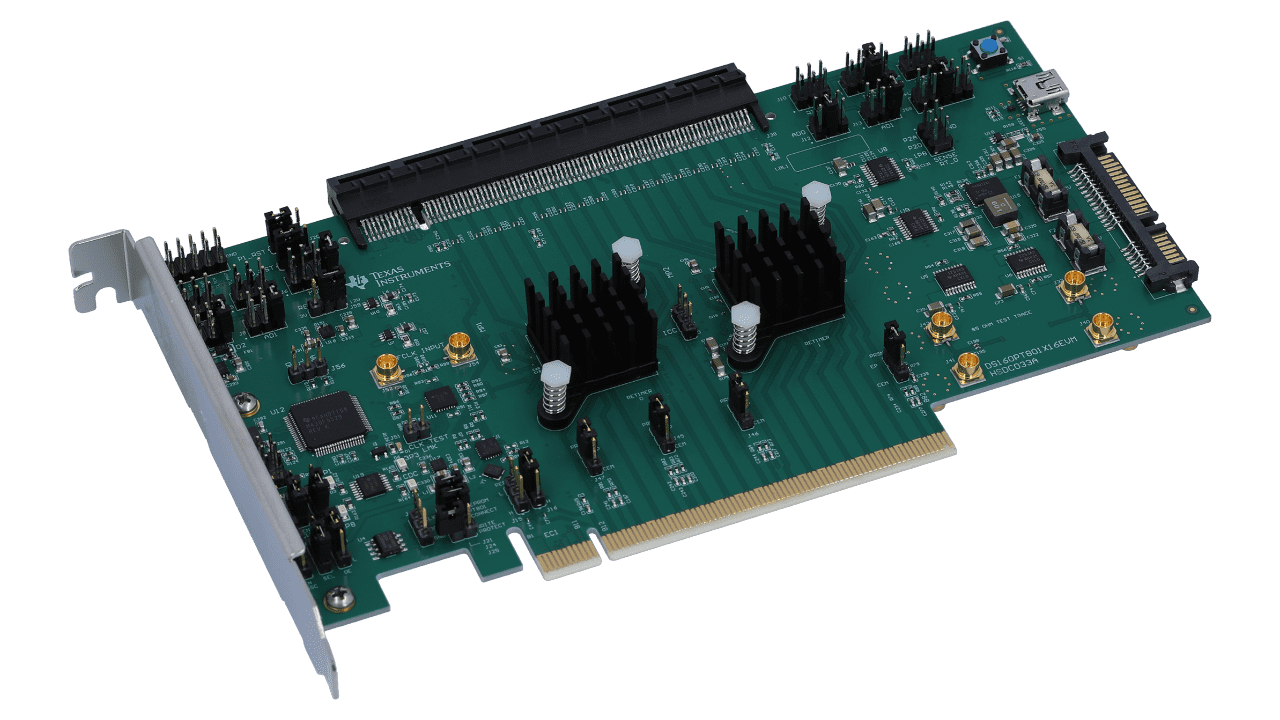-
DS160PT801X16EVM Riser Card Evaluation Module
DS160PT801X16EVM Riser Card Evaluation Module
Abstract
The DS160PT801X16EVM is a 16-lane PCIe riser card board intended to be used for evaluation of the Texas Instruments DS160PT801 PCIe Gen4 retimer. The EVM uses the 1x16 Card Electromechanical (CEM) connector to enable quick system testing in a standard x16 socket and a standard PCIe endpoint. The evaluation board may be used with the SigCon Architect software program to provide register control and status information from the DS160PT801 devices. Contact a local Texas Instruments representative to obtain the SigCon Architect.
 Figure 1-1 DS160PT801 EVM
Figure 1-1 DS160PT801 EVMTrademarks
Windows® is a registered trademark of Microsoft Corporation.
All trademarks are the property of their respective owners.
1 EVM Control and Configuration Information
The DS160PT801X16 EVM uses an AT24C16 EEPROM to store retimer configuration settings. This EEPROM is pre-loaded with an EEPROM image with various settings to enable quick system bring-up for common-clock PCIe topologies.
Custom EEPROM images for compliance or separate reference independent spread (SRIS) clock topologies may be created and written to the EEPROM using the SigCon Architect software or by using the DS160PT801 I2C interface. For additional information on EEPROM programming through the I2C interface of the DS160PT801, please refer to the DS160PT801 EEPROM Programming Guide.(1)
 Figure 1-1 DS160PT801X16EVM EEPROM
Control and Connection
Figure 1-1 DS160PT801X16EVM EEPROM
Control and ConnectionThe EE-PT801 connect headers (J21 and J24) allow for quick connection or disconnection of the EEPROM serial interface. Additional test access points are provided at header J23 to allow the user to monitor EEPROM activity. The J25 header may be used to Write Protect the EEPROM and prevent any changes to the current EEPROM image. When the EEPROM is disconnected, the retimer will completely rely on the pin-strap settings for configuration, which may be modified using the shunt jumpers included with the EVM.
1.1 Retimer Pin Controls
The DS160PT801X16EVM is pre-configured on power-up to use the retimer configuration stored in the onboard EEPROM. These settings may be adjusted by using the pin controls through the onboard headers and jumpers. There are 3 types of headers on the EVM for pin-controls: 2-level, 4-level, and 5-level headers. This section highlights the pin controls and how to adjust them. Additional information about pin settings is provided in the DS160PT801 data sheet.
Jumper options for 2-Level, 3-pin headers are as follows:
- No jumper on header pins – Input floating
- Shunt jumper at pins 1-2 – Input to 1.8 V or 3.3V
- Shunt jumper at pins 2-3 – Input to GND
Jumper options for 4-Level, 6-pin headers are as follows:
- No jumper on header pins – Input floating
- Shunt jumper at pins 1-2 – Inputs to 1.8 V
- Shunt jumper at pins 3-4 – Inputs 10 kΩ to GND
- Shunt jumper at pins 5-6 – Inputs to GND
Jumper options for 5-Level, 8-pin headers are as follows:
- No jumper on header pins – Input floating
- Shunt jumper at pins 1-2 – Inputs to 1.8 V
- Shunt jumper at pins 3-4 – Inputs 10 kΩ to 1.8 V
- Shunt jumper at pins 5-6 – Inputs 10 kΩ to GND
- Shunt jumper at pins 7-8 – Inputs to GND
| Header Designator | Jumper Position | Description |
|---|---|---|
| J1 | 1-2 | Disable CDCE6214 SSC clocking |
| J2 | 1-2 | Disable CDCE6214 clock output |
| J4 | 2-3 | Disable CDCE6214 EE_SEL |
| J6 | 7-8 | Set retimer U2 mode to dual-chip link-width manager |
| J7 | 5-6 | Set retimer U2 SMBus address to 0x20 |
| J8 | 5-6 | Set retimer U2 SMBus address to 0x20 |
| J11 | 5-6 | Set retimer U3 mode to dual-chip link-width follower |
| J12 | 3-4 | Set retimer U3 SMBus address to 0x22 |
| J13 | 5-6 | Set retimer U3 SMBus address to 0x22 |
| J16 | 2-3 | Assert CLKREQ#, 1 K pulldown to GND |
| J18 | 1-2 | Deassert Port 0 PRTRST#, 1 K pullup to 1.8 V |
| J20 | 1-2 | Deassert Port 1 PRTRST#, 1 K pullup to 1.8 V |
| J21 | 1-2 | Connect EE_CLK to retimer, enable EEPROM |
| J24 | 1-2 | Connect EE_DAT to retimer, enable EEPROM |
| J45 | 1-2 | Endpoint control of PRSNT#2 PCIe signal |
| J46 | 1-2 | Endpoint control of PRSNT#3 PCIe signal |
| J47 | 1-2 | Endpoint control of PRSNT#1 PCIe signal |
| J48 | 1-2 | Endpoint control of PRSNT#4 PCIe signal |
| J49 | 2-3 | Use clock source from CEM connector for REFCLK |
| J50 | 2-3 | Disable clock output from LMK00334 |
| J58 | 3-4 | Set voltage regulator to output 1.15 V |
| J59 | 1-2 | Enable U16 voltage regulator with 12 V supply |